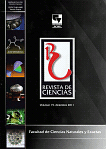Magnetic and Structural Characterization of Mechanically Alloyed Fe50co50 Samples
Contenido principal del artículo
Samples of nominal composition Fe50Co50 were produced by mechanical alloying byusing a planetary ball mill and different milling times. The samples were studied via X-raydiffraction, Mössbauer spectroscopy, and X-ray photoelectron spectroscopy to characterize thephase distribution resulting from the milling process. The Mössbauer data indicated that Co startsdiffusing into Fe after 8 h of milling. Between t = 8h and t = 24 h the sample has a heterogeneouscomposition, presenting a bimodal hyperfine field distribution with maxima centred at 34.3 T and35.8 - 36.4 T, compatible with the presence of different Fe environments (richer in Co and richerin Fe, respectively). After 48 h of milling, the sample presents a more homogeneous compositionshowing an almost symmetric hyperfine magnetic field distribution centred at H=34.9 T,indicating that a disordered equiatomic FeCo solid solution has already been formed. The X-rayphotoelectron spectroscopy data indicate that the native oxide layer formed on the freshly milledsamples contains Co2+, Fe2+ and Fe3+ oxides. After complete removal of this native oxide layer byAr ion bombardment, X-ray photoelectron spectroscopy analysis yields the composition of thenominal equiatomic Fe50Co50 alloy.

Esta obra está bajo una licencia internacional Creative Commons Atribución-NoComercial-CompartirIgual 4.0.





